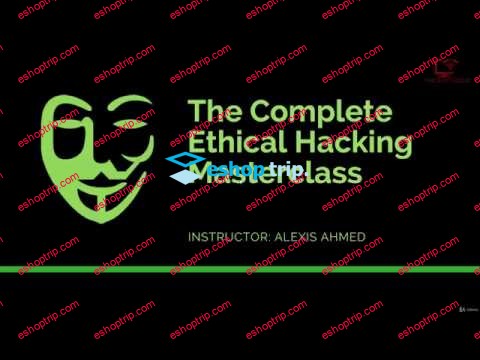Published 11/2024
MP4 | Video: h264, 1920×1080 | Audio: AAC, 44.1 KHz
Language: English | Size: 6.16 GB | Duration: 18h 19m
Master Cybersecurity & Ethical Hacking: From Vulnerability Assessment to AI-Driven Threat Detection
What you’ll learn
Set Up a secure virtual lab environment with Kali Linux, Metasploitable 2, and Windows VMs for safe cybersecurity practices.
Explore the phases of ethical hacking and understand how to apply the CIA and DAD triads in cybersecurity strategies.
Use anonymity tools such as VPNs, proxies, and TOR to protect online identities and maintain digital privacy.
Conduct passive information gathering with tools like Whois, NMAP, and Google Dorks to assess vulnerabilities.
Analyze and assess vulnerabilities in web applications, identifying SQL injection and cross-site scripting (XSS) threats.
Perform penetration testing and utilize vulnerability assessment tools like Nessus and Metasploit to test network security.
Mitigate common cyber threats, including malware, spyware, trojans, and password attacks, to enhance system defenses.
Learn the AI techniques employed in cybersecurity for threat detection, incident response, and process automation in security systems.
Defend against social engineering attacks, phishing, and identity theft with best practices for social engineering resilience.
Assess mobile and WiFi security risks, applying countermeasures for mobile vulnerabilities and WiFi network protection.
Requirements
No prior experience is required; this course is beginner-friendly and includes step-by-step guidance—just bring a computer with internet access and a willingness to learn.
Description
Are you an aspiring cybersecurity professional, an ethical hacker at heart, or someone intrigued by the hidden world of digital security? Imagine having the ability to protect systems, secure data, and prevent cyber threats. This course, Zero to Hero in Cybersecurity and Ethical Hacking, is designed to take you from a beginner to a proficient cybersecurity expert, providing you with the knowledge and practical skills needed to safeguard systems and data in today’s tech-driven world.In this course, you’ll dive into every aspect of cybersecurity and ethical hacking, from setting up a secure virtual lab to hands-on penetration testing, vulnerability assessments, social engineering, and the integration of AI in threat detection. You’ll build an in-depth understanding of cybersecurity principles, tools, and best practices through practical, real-world activities.In this course, you will:Set Up a complete virtual lab environment with VMware, Kali Linux, Metasploitable 2, and more, to practice your skills safely.Master the essentials of ethical hacking, including different phases of hacking, CIA and DAD triads, zero trust, and compliance standards.Explore various anonymity tools and methods to secure online identities, including VPNs, proxies, and TOR.Conduct in-depth passive information gathering, learning about tools like Whois, BuiltWith, NMAP, and Google Dorks.Analyze and report on vulnerabilities with a focus on VAPT (Vulnerability Assessment and Penetration Testing) and OWASP.Engage in penetration testing and identify SQL injections, command injections, and XSS vulnerabilities in web applications.Gain Hands-on Experience with popular hacking tools such as Burp Suite, SQLMap, John the Ripper, Nessus, and Metasploit.Protect against various malware, understand types of viruses, spyware, and trojans, and conduct malware detection and removal.Learn AI-driven Cybersecurity strategies, from threat detection to automated response systems and the ethical implications of using AI in cybersecurity.With cyber threats constantly evolving, cybersecurity knowledge is crucial for anyone in today’s digital landscape. This course offers you the chance to practice real-world hacking techniques in a controlled environment, understand the mindset of cybercriminals, and strengthen your defenses against digital threats.Throughout this course, you’ll work on practical exercises, case studies, and hands-on hacking labs that will help you develop real-world cybersecurity skills. Guided by an experienced instructor, you’ll gain insight into industry best practices and advanced topics, including AI in cybersecurity.Ready to become a cybersecurity hero? Enroll now and start your journey into the dynamic and rewarding world of ethical hacking and cybersecurity!
Overview
Section 1: Introduction
Lecture 1 Introduction to ethical hacking
Section 2: Setting Up a Virtual Lab
Lecture 2 Creating Virtual Lab
Lecture 3 Enabling Virtualization in BIOS
Lecture 4 Downloading Virtual Lab Tools
Lecture 5 Installing VMware workstation player
Lecture 6 Installing and configuring Kali Linux
Lecture 7 Installing and configuring Metasploitable 2
Lecture 8 Installing and configuring Windows VM
Lecture 9 Testing VM Lab
Lecture 10 Legal Ethical Disclaimer
Section 3: Introduction to Ethical Hacking & Cybersecurity
Lecture 11 Why we need cybersecurity
Lecture 12 Ethical hacking vs Cybersecurity
Lecture 13 Phases Of hacking
Lecture 14 Types of Hackers
Lecture 15 CIA Triad
Lecture 16 Info Sec Controls
Lecture 17 DAD Triad
Lecture 18 Zero Trust
Lecture 19 Non-Repudiation
Lecture 20 AAA of Security
Lecture 21 Gap Analysis
Lecture 22 Complaince Standards
Lecture 23 Cybersecurity Terminologies
Section 4: Computer Networking & Anonymity Tools
Lecture 24 Introduction to Networking
Lecture 25 Objectves of Networking
Lecture 26 How Data Travels
Lecture 27 Types of Networks
Lecture 28 Understanding IP Addresses
Lecture 29 Role of IP Addresses
Lecture 30 Understanding NAT
Lecture 31 Understanding Ports
Lecture 32 Understanding Services
Lecture 33 Ports and Services
Lecture 34 Protocols and OSI Model
Lecture 35 Protocols and TCP IP Model
Lecture 36 Understanding DNS
Section 5: Anonymity tools
Lecture 37 Online Anonymity and VPN
Lecture 38 Hands on Using VPN
Lecture 39 Anonymity tools Proxy
Lecture 40 Hands on Using Proxy
Lecture 41 TOR The Onion Router
Lecture 42 Hands on Using TOR
Section 6: Passive Information Gathering
Lecture 43 Introduction Passive Info Gathering
Lecture 44 Using Whois
Lecture 45 Using Builtwith
Lecture 46 Reverse IP Lookup
Lecture 47 Subdomain Finder
Lecture 48 Footprinting Social Media
Lecture 49 People Finder Tools
Lecture 50 Using Archive.org
Lecture 51 Email Extractor Pro
Lecture 52 Have I been pawned
Lecture 53 Temp Mail
Lecture 54 Spoofing Emails
Lecture 55 Tracing Emails
Lecture 56 Fake ID Generator
Lecture 57 Google Dashboard
Lecture 58 Google Dorks
Lecture 59 Default Passwords
Lecture 60 Introduction to NMAP
Lecture 61 NMAP Scanning Multiple IPs
Lecture 62 NMAP Subnet Scanning
Lecture 63 NMAP Ports Scanning
Lecture 64 NMAP Storing Output
Lecture 65 NMAP Scanlist
Lecture 66 Zenmap for Windows
Section 7: VAPT & OWASP : Vulnerability Management
Lecture 67 Understanding Vulnerabilities
Lecture 68 Memory Injection Buffer Overflow
Lecture 69 Race Conditions
Lecture 70 Preventing Race Conditions
Lecture 71 Malicious Updates
Lecture 72 OS Vulnerabilities
Lecture 73 SQL Injections
Lecture 74 XSS Vulnerabilities
Lecture 75 Hardware Vulnerabilities
Lecture 76 VM Vulnerabilities
Lecture 77 Cloud Vulnerabilities
Lecture 78 Mitigating Cloud Vulnerabilities
Lecture 79 Supply Chain Vulnerabilities
Lecture 80 Mitigating Supply Chain Vulnerabilities
Lecture 81 Cryptographic Vulnerabilities
Lecture 82 Mitigating Cryptographic Vulnerabilities
Lecture 83 Misconfiguration Vulnerabilities
Lecture 84 Mitigating Misconfiguration Vulnerabilities
Lecture 85 Mobile Device Vulnerabilities
Lecture 86 Mitigating Mobile Device Vulnerabilities
Lecture 87 Zero Day Vulnerabilities
Lecture 88 Vulnerability Management
Lecture 89 Vulnerability Assessment
Lecture 90 Types of Vulnerability Assessment
Section 8: Vulnerability Management Life cycle
Lecture 91 Vulnerability Management Life cycle
Lecture 92 Vulnerability Assessment Pre-Engagement Process
Lecture 93 Vulnerability Assessment Post-Engagement Process
Lecture 94 Vulnerability Scanning
Lecture 95 Application Security Scanning
Lecture 96 Threat Feeds
Lecture 97 Penetration Testing
Lecture 98 Bug Bounty Programs
Lecture 99 False Positives False Negatives
Lecture 100 Creating and Maturing vuln assessment program
Lecture 101 Implementing Infrastructure Vuln Management Lifecyle
Lecture 102 Implementing Application Vuln Management Lifecyle
Lecture 103 Implementing Cloud Vuln Management Lifecyle
Lecture 104 Implementing Overall Vuln Management Lifecyle
Lecture 105 Common Industry Challenges
Lecture 106 Best Practices
Section 9: Vulnerability Management case study
Lecture 107 Case Study Mature VM Program
Lecture 108 Case Study Immature VM Program
Lecture 109 Lessons Learnt
Lecture 110 Patch Management, Updates, Hotfixes
Section 10: VAPT & OWASP : Analysis & Reporting
Lecture 111 Understanding CVSS Score
Lecture 112 Understanding CVE
Lecture 113 Hands on CVE Analysis
Lecture 114 Understanding CWE
Lecture 115 Accessing Vulnerability Databases
Lecture 116 Mitre Attack Framework
Lecture 117 National Vulnerability Database
Lecture 118 OWASP TOP 10
Lecture 119 SANS Top 25
Lecture 120 Information gathering for Endpoints
Lecture 121 How Information gathering for Endpoints Helps
Lecture 122 Information gathering tools for Endpoints
Lecture 123 End Point Vulnerability Assessment with NMAP
Lecture 124 Vulnerability Assessment with Nikto
Section 11: VAPT & OWASP : Penetration Testing & OWASP
Lecture 125 Using MBSA Tool for Windows Vulnerability Assessment
Lecture 126 Using Pen test Tool for Online Web Application VA
Lecture 127 Installing Nessus Vulnerability Assessment Tool
Lecture 128 Using Nessus for Host Discovery
Lecture 129 Using Nessus for Basic Network Vulnerabilities Scan
Section 12: Web Application Attacks
Lecture 130 Introduction to Web Applications
Lecture 131 Hacking Web Applications
Lecture 132 Textboxes in Web Applications
Lecture 133 Parameter Tampering
Lecture 134 Hand On Parameter Tampering
Lecture 135 What is command Injection
Lecture 136 Hands On command Injection
Lecture 137 Understanding Reflected XSS Attacks
Lecture 138 Hands On Reflected XSS Attacks
Lecture 139 Understanding Stored XSS Attacks
Lecture 140 Hands On Stored XSS Attacks
Lecture 141 Introducing Burpsuite
Lecture 142 Configuring Burpsuite
Lecture 143 Using Burpsuite for session hijacking
Section 13: SQL Injections
Lecture 144 Intro to Database and SQL
Lecture 145 Understanding SQL Injections
Lecture 146 Intro to Authentication Bypass
Lecture 147 Understanding How Authentication Bypass Works
Lecture 148 Hands on Simple Authentication Bypass
Lecture 149 Intro to SQLMap
Lecture 150 Hands on SQLMap
Lecture 151 Preventing SQL attacks
Section 14: Steganography
Lecture 152 Introduction to Password Hacking and Steganography
Lecture 153 Types of Steganography
Lecture 154 Image Steganography
Lecture 155 Image Steganography Hands on using Quick Stego
Lecture 156 Image Steganography Hands on using Open Stego
Lecture 157 Image Steganography Hands on using Online Stego
Lecture 158 Mobile Steganography Tools
Lecture 159 Audio Steganography
Section 15: Password Hacking
Lecture 160 Keyloggers
Lecture 161 Defence against Keyloggers
Lecture 162 Software Keyloggers
Lecture 163 Introduction to Spyware
Lecture 164 Hands on Using Spytech Spyware
Lecture 165 Defending against spyware
Lecture 166 Password Cracking Techniques
Lecture 167 Password Cracking Attacks
Lecture 168 Understanding Hashes and SAM
Lecture 169 Using Rockyou.txt
Lecture 170 Using Rockyou.txt in Kali Linux
Lecture 171 Using Cewl tool for dictionary
Lecture 172 Using Crunch tool for dictionary
Lecture 173 Password Strength
Lecture 174 Hacking Passwords with John the Ripper
Lecture 175 Hacking Documents Passwords Online
Lecture 176 Understanding Rainbow Tables
Lecture 177 Windows Password Cracking Tools
Lecture 178 Windows Password Cracking Part2
Lecture 179 Windows Password Cracking Part3
Lecture 180 What is Metasploit Framework
Lecture 181 Creating Metasploit Payload
Lecture 182 Creating Metasploit Payload Part 2
Lecture 183 Creating Metasploit Payload Part 3
Section 16: Understanding Malware and its types
Lecture 184 Introduction to Malware
Lecture 185 Why are Malware Created
Lecture 186 How are Malware Spread
Lecture 187 Types of Malware
Lecture 188 Types of Virus
Lecture 189 Boot Sector Virus
Lecture 190 Macro Virus
Lecture 191 Program Virus
Lecture 192 Multipartite Virus
Lecture 193 Encrypted Virus
Lecture 194 Stealth Viruses
Lecture 195 Armored Virus
Lecture 196 Hoax Virus
Lecture 197 Worm Virus
Lecture 198 Backdoor
Lecture 199 Logic Bomb
Lecture 200 Ransomware
Lecture 201 Grayware
Lecture 202 Spyware
Lecture 203 Rootkits
Lecture 204 SPAM and SPIM
Lecture 205 Bloatware
Lecture 206 Trojan Horse
Lecture 207 Why Create Trojan
Lecture 208 Types of Trojans
Lecture 209 Trojan Kits
Lecture 210 RAT – Remote Access Trojan
Lecture 211 RAT Kits
Lecture 212 Fileless Malware
Section 17: Hands-on virus creation
Lecture 213 Virus Creation Tools
Lecture 214 Simple Batch Virus Ex1
Lecture 215 Adding Shutdown Virus to Startup
Lecture 216 Creating Fork Bomb Virus
Lecture 217 Creating Application Flood Virus
Lecture 218 Creating Infinite Folders Virus
Lecture 219 Creating Virus With JPS Virus Maker
Lecture 220 Creating Virus With Bhavesh Virus Maker
Section 18: Detecting and removing malware
Lecture 221 Symptoms of virus and Malware
Lecture 222 Detecting Viruses
Lecture 223 Removing Malware
Lecture 224 Hands on Malware Detection
Section 19: Social Engineering
Lecture 225 Introduction to Social Engineering
Lecture 226 Impact of Social Engineering Attacks
Lecture 227 Effectiveness of Social Engineering
Lecture 228 Insider Threats
Lecture 229 Impersonation
Lecture 230 Identity Theft
Lecture 231 Identity Theft Countermeasures
Lecture 232 Deep Fakes
Lecture 233 Phishing
Lecture 234 Phishing Examples
Lecture 235 Popular Phishing Scams
Lecture 236 Hands On Phishing Using SET Templates
Lecture 237 Hands on Phishing Using SET Live Website
Lecture 238 Protecting against Social Engineering attacks
Section 20: Mobile Hacking & Security
Lecture 239 Mobile Platform Vulnerabilities
Lecture 240 OWASP Top 10 Mobile Risks
Lecture 241 Types of Mobile Security
Lecture 242 Traffic Security
Lecture 243 Barrier Security
Lecture 244 IMEI Number
Lecture 245 Lost Mobile Phone
Lecture 246 Hands On Find My Device
Lecture 247 Hands On IMEI Tracker
Lecture 248 Hands On Lost Stolen Mobile
Lecture 249 Mobile Malware
Lecture 250 Mobile Rooting
Lecture 251 Mobile Device Management (MDM)
Lecture 252 MDM Key Features
Lecture 253 Popular MDM Solutions
Lecture 254 Lab setup for Android Payload Hacking
Lecture 255 Hands On Android Payload Part 1
Lecture 256 Hands On Android Payload Part 2
Lecture 257 Hands On Android Payload Part 3
Lecture 258 Hands On Android Payload Part 4
Lecture 259 Mobile Hardening
Section 21: WIFI Hacking & Security
Lecture 260 Wifi Network Concepts
Lecture 261 Benefits of Wifi
Lecture 262 Wifi Network Concepts
Lecture 263 Wifi Encryptions
Lecture 264 Wifi Attack Vectors
Lecture 265 What is MAC Address
Lecture 266 Hands On MAC Spoofing In Windows
Lecture 267 Hands On MAC Spoofing In Kali Linux
Lecture 268 Hands On Sniffing WIFI Traffic Part 1
Lecture 269 Hands On Sniffing WIFI Traffic Part 2
Lecture 270 Hands On Sniffing WIFI Traffic Part 3
Section 22: AI & The Future of Cyber Security
Lecture 271 Introduction to AI
Lecture 272 What is AI
Lecture 273 Role of AI in Cybersecurity
Lecture 274 Role of AI in Improving Cybersecurity
Lecture 275 AI in Threat Detecting
Lecture 276 AI in Threat Prediction
Lecture 277 AI in Incident Response
Lecture 278 AI in Intrusion Prevention Systems IPS
Lecture 279 Introduction to Gen AI
Lecture 280 Cybersecurity with Gen AI
Lecture 281 Detection Rules with AI
Lecture 282 Security Reports with AI
Lecture 283 Ethical Implications of AI
Lecture 284 Responsible AI
Lecture 285 AI Case study 1 Darktrace Threat Detection with AI
Lecture 286 AI Case study 2 Cylance Malware Detection with AI
Lecture 287 AI Case study 3 Microsoft AI in Phishing Detection
Lecture 288 Success Story 1 Capital One
Lecture 289 AI Success Story 2 JP Morgan Chase
Lecture 290 AI Success Story 3 Netflix
Lecture 291 AI Integration with traditional Cyber Security method1 and 2
Lecture 292 AI Integration with traditional Cyber Security method3 and 4
Lecture 293 Cyber Threats Due to AI Part 1
Lecture 294 Cyber Threats Due to AI Part 2
Lecture 295 Deep Fakes Part 1
Lecture 296 Deep Fakes Part 2
Lecture 297 Deep Fakes Part 3
Lecture 298 Worm GPT
Lecture 299 Practical Applications in Threat Hunting
Lecture 300 Automating Security With GenAI
Lecture 301 Process Automation
Lecture 302 Orchestration
Lecture 303 Case Management
Lecture 304 SSL Certificate Management
Lecture 305 Ticket Management with AI
Lecture 306 Conclusion
Aspiring Cybersecurity Professionals who want to gain practical skills in ethical hacking and system protection.,IT Administrators seeking to enhance their understanding of vulnerability management and secure network configurations.,Computer Science Students interested in exploring real-world cybersecurity tools and hands-on hacking techniques.,AI and Data Professionals aiming to integrate AI-driven threat detection and automation into cybersecurity practices.,Tech Enthusiasts curious about the fundamentals of ethical hacking and cybersecurity principles.,Business Owners looking to understand cybersecurity threats and protect their organization’s digital assets.
https://anonymz.com/?https://www.udemy.com/course/cybersecurity-and-ethical-hacking/










